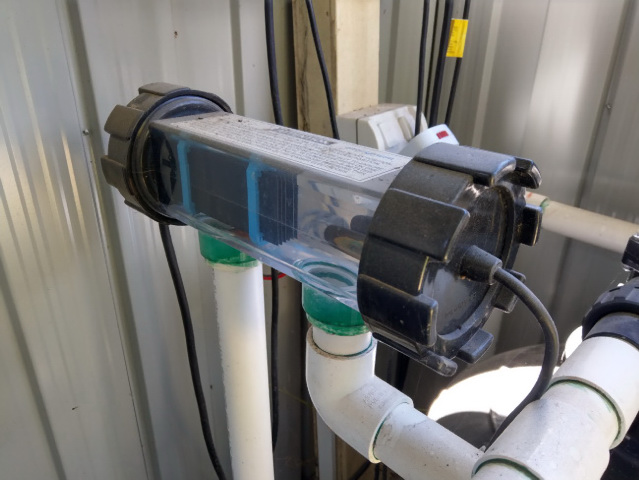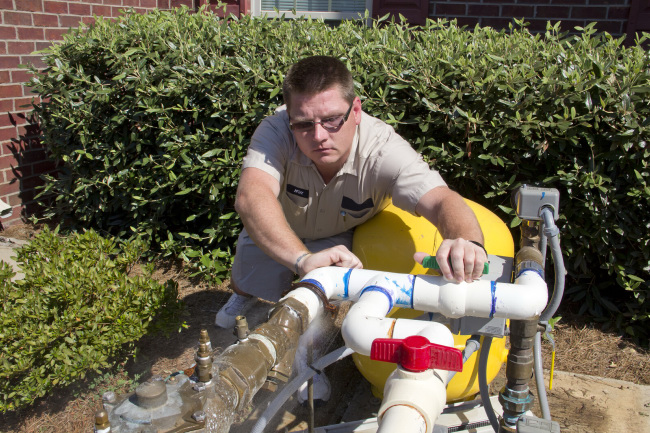Leaks in saltwater cells are common. Sometimes they leak from the unions, where the power cords are, or they develop cracks. It’s super annoying and you’re probably wondering how you can fix it or if you need to replace it.
Let’s find out how to fix a leaking salt cell (aka saltwater chlorine generator or SWG).
It is possible to fix a leaking or cracked saltwater cell. The main culprits for leaks are the unions not sitting properly (cross-threading) and old or dirty o-rings in the lid of the cell unit or in the unions. Sometimes cracks in the body of the salt cell or pipes occur. You can fix by tightening unions, replacing o-rings or repairing the crack. And these steps work for salt cells from Jandy, Hayward, Autopilot, Pentair, and others.

Taking the steps to prevent any worse or lasting problems with your saltwater system is common sense for pool owners. So, read on to find out how to fix your salt chlorinator cell and keep it from leaking again.
Article Contents
What to Do If Salt Cell is Leaking
First I want to clarify this article is to fix a leaking salt cell or saltwater generator (sometimes called a chlorinator). It’s not to fix a chlorine feeder, which is also sometimes called a chlorinator. If you have a leaking chlorine feeder, we have an article here: How to Fix a Leaking Chlorinator
Before we look at fixing your leaking salt cell, here’s what you should do if the salt cell is leaking.
- Keep the filter running if possible
- Keep up the chlorine and other chemicals
- Find the leak
1. Keep Filtering
If the leak is large and lots of water is coming out, you’ll need to shutdown the system. If you do shutdown the system, you’ll need to manually scoop out debris from the water and add chemicals.
But if the leak is small, it’s OK to keep running the system. Ideally, you’ll want to keep filtering your pool’s water as normal. A lack of filtering can mean cloudy pool water in your salt water pool. If you have cloudy water, check out our article:
15 Reasons Why Your Saltwater Pool Is Cloudy (How to Clear)
In some systems, they may have a saltwater cell bypass valve. This will allow you to keep the filter running without the water running through the salt cell. Do this if you can.
2. Keep Up the Chlorine
Remember, if you shutdown your saltwater chlorine generator (sometimes call a chlorinator) for more than a day or so, your pool will not stay clean and could go cloudy or develop algae.
Test your water regularly during this time and add chlorine manually. Providing your stabilizer levels are correct (30-60 ppm) you can use liquid chlorine. It’s best to add it at night and keep the chlorine levels at 3-5 ppm.
3. Find the Leak
Now you want to find the leak. Usually, it shouldn’t be too hard to spot. And besides that, it only leaks from a few spots:
- Leaking from unions or o-rings
- Leaking from cracked salt cell housing (body)
- Leaking from cracked PVC pipe
Start by grabbing a cloth and drying off any dripping or leaking water.
Carefully inspect the areas around where the water was. You’re looking for cracks. Sometimes they are tiny hairline cracks and can be hard to see.
If you can’t see any obvious cracks or problems, turn the system back on a look carefully where the water starts leaking from. This will give you a fairly good idea of where the issue is.
Now it’s time to fix your leaking salt cell.
Water Leaking from Unions
If you notice water leaking from the unions of your saltwater cell, you can easily solve the problem yourself. Water leaking from the union could be from someone not screwing it back into place properly after a maintenance check.
Cross-threading is the technical term when a fastener (the union in this case) isn’t properly in alignment with the thread.

Or maybe the leak is because of a dirty or clogged o-ring preventing the union from getting a good seal. Follow these steps to fix a leaking union yourself:
- Turn off the pool pump. Or switch off the breaker.
- Loosen one of the unions fully, exposing the pipeline underneath – water will come out.
- Check the o-ring to make sure it’s free of dirt and seated correctly. Check it’s in good condition (not cracked or perished). Renew if necessary.
- Then, simply reposition the loosened pipe over the bottom pipeline.
- After that, begin screwing the union back into the base. Before you screw it down fully, gently shake the pipe to make sure it’s completely in align with the base. It should start screwing on without too much resistance. If it’s really tight to start, it may be cross-threaded.
- Repeat these steps for the second union, double-checking the quality and position of the o-ring. You’ll need to lubricate the o-ring too – details below.
- Once both are securely in place, switch on the breaker and pool pump.
After completing these steps, there shouldn’t be any leakages from the unions. If there is, and you think it’s because of the o-rings, you can easily get replacements ones.
Where to get o-rings: The best way to get new o-rings is use the manufacturer specific parts. They design o-rings for specific models and you’ll want the perfect fit for your salt generator cell to work correctly. Check out Amazon or a pool supply store.
What Type of O-ring Lubricant Should You Use?
It might be a silly question to some pool owners but choosing the right lubricant is important in extending the lifespan of the new o-ring. When you’re picking what lubricant to get, be certain that it is a silicone-based lubricant. Unfortunately, the obvious lubricant WD-40 won’t do.
A popular lubricant pool owners and experts use is the Aladdin Magic Lube. It has a rating of 4.7 stars out of 777 Amazon reviews. Many high rating buyers find it to be the best option for lubricating their pool’s o-rings. However, some customers note that it’s incredibly sticky and may not suit all the o-rings of your pool.
How to Fix a Cracked Salt Cell Housing
Can you fix a cracked salt cell housing?
Repairing a cracked salt cell housing is possible. There are several products on the market specifically designed to repair damaged and leaking pipes. These products can fix cracks, holes or other damage. The repair job may not be as good as new, however, in most cases you should be able to extend the life of your damaged salt cell.
Here’s our recommendations for fixing a cracked Salt Cell
- Repair pipes, glue pool tiles on, fix plastic components
- Can withstand high temperatures
- Will cure underwater
This product gets many rave reviews. That’s because it will set even if wet or underwater. It’s perfect for fixing leaks in a saltwater generator cell. Either cracks, fractures or holes. It’s designed to stick on plastics as well as metals.
All you need to do is clean the surface you’re applying it to, mix the two parts together and apply. It will be dry in 25-60 mins.
- Repairs and rebuilds plastic compounds & surfaces
- ABS, PVC & Cpvc pipes, plastics, vinyl
- Bonds instantly (25 mins to set /3 hr cure)
Many people have had a lot of success using this product to repair PVC pipes. It’s designed for PVC, ABS and other common plastics. Like the plastic your salt cell is made from. It doesn’t adhere to some plastics such as Polyethylene, which is what plastic bags are made from.
To use it, you just need to clean the surface and give it a quick sand to rough it up. Then after working the putty, stick it down and in 2-3 hours, it’s dried and cured.
For less than $8 it’s certainly worth a try.
How to Fix a Cracked Salt Cell Pipe
Can you fix a damaged or cracks PVC pipe on your salt cell?
It is possible to fix damaged, leaking pipes that connect to your saltwater generator cell. There are some products on the market that will repair pipes with cracks, holes and other leaks.
You can try:
You may also consider a pipe repair bandage or tape like this product.
- Can handle temperature up to 500F and pressure up to 950 PSI
- Creates an air-tight, waterproof seal in seconds
- Excellent insulant
This product is approved by the US military. You know when the military approves a product, it must work.
Unlike the J-B Weld products, which are epoxies, this is a tape and wraps around the pipe meaning you can potentially seal up a bigger hole or crack. Most users have reported good success with this product.
Related Reading: What Do The Numbers On A Saltwater Generator Mean?
Final Thoughts
Finding the source of leaking water from your salt cell isn’t usually too hard to do. Most of the time you should be able to at least temporarily repair the leak. If this is the case, it’s worth contacting the salt cell’s manufacturer to see if they can help, especially if the salt cell is still in warranty.
According to a popular pool forum, some manufacturers will still honor their warranty even if it’s a few weeks or months outside of it. So, it’s worth approaching them if the described solutions above don’t work for your leaking salt chlorinator cell.




